Parent's Guide to Dental Health From Pregnancy to Young Adulthood.
Table of Contents
- Pregnancy & Baby's Teeth
- Changes During Pregnancy
- Pregnancy Dental Care
- Mom's Diet Matters
- At-Home Care
- Professional
- Healthy Foods
- Teen Dental Health
- Orthodontics
- Reinforce Good Habits
- Parent's Important Role
A healthy mouth begins in the womb. The way moms eat, clean their teeth, and work with medical professionals all have a profound impact on the health of the baby's teeth.
After birth, parents, children, and dentists work together to preserve the child's healthy smile. Kids have a lot to learn at this stage, but parents can get creative and make those critical lessons fun.
When kids move into the teen years, they may forget some of those critical lessons. Reminders are critical. Parents may also need to plan ahead for the onset of braces or aligners.
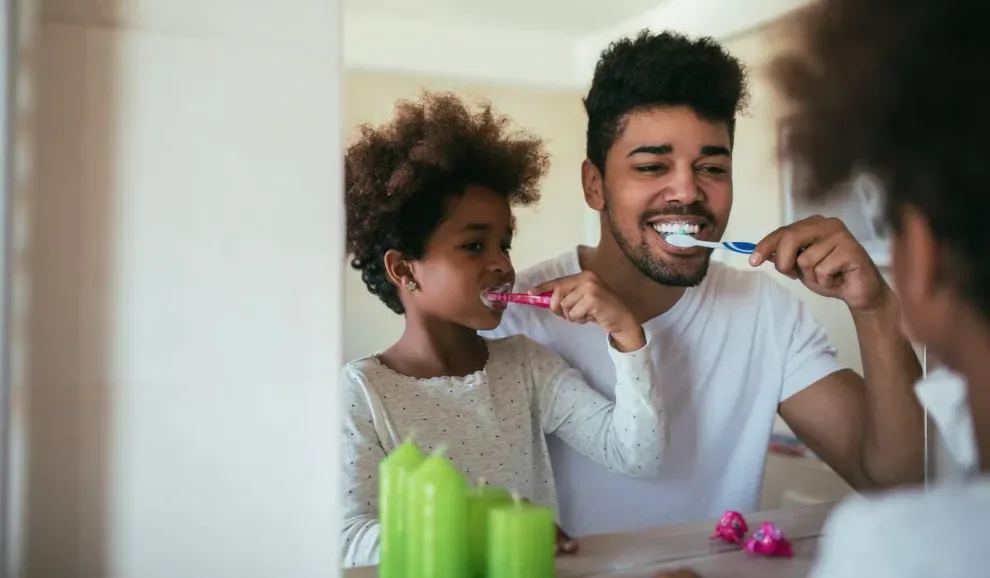
Pregnancy and baby's teeth.
We all know babies aren't born with a full set of pearly whites. But a mom's decisions during pregnancy can have a deep impact on a child's adult smile.
In some cases, a mother’s oral health can determine whether or not her baby stays healthy during pregnancy.
How mom's mouth changes during pregnancy.
Carrying a baby changes almost everything about a woman's body. Your teeth and gums are changing too.
The March of Dimes reports that these common issues can impact a mom's teeth and gums:
Progesterone and estrogen levels shift during pregnancy, and that can increase your risk of some dental problems.
Cravings may drive you to eat foods you would normally avoid. Sometimes, the things your body wants (like chips) aren't good for your teeth.
Brushing and flossing may slip to the bottom of your to-do list at the end of a long day of pregnancy.
Some women feel queasy after using toothpaste.
Shifting hormone levels can also impact your gums, researchers say.
Some women experience so-called pregnancy gingivitis in which their gums swell and bleed during pregnancy.
In fact, according to the Centers for Disease Control and Prevention, up to 75 percent of pregnant women have this problem.
These aren't just cosmetic concerns. The American Academy of Pediatrics reports that bacteria growing on a mother’s teeth can slide below the gums, into the bloodstream, and down the placenta into baby's body. That can trigger premature labor.
Dental care during pregnancy.
Moms can and should continue with routine oral care during pregnancy. That means brushing your teeth, flossing, and using a non-alcohol mouthwash should all be on your daily to-do list. Seeing a dentist remains critical too.
Women with gums that bleed can benefit from two types of treatment only dentists can give, researchers say.
Deep root scaling: Doctors use sharp, thin tools to reach below the gumline and pull up layers of plaque.
Topical treatment: Doctors can brush on a topical antibiotic to kill bacteria. When colonies are smaller, inflammation levels fade.
It's safe to visit a dentist during pregnancy, but you should tell your dentist that you're pregnant. Your dentist might use extra precautions when offering x-rays, for example. And you might discuss delaying intensive procedures, like extractions, until you're past the first trimester.
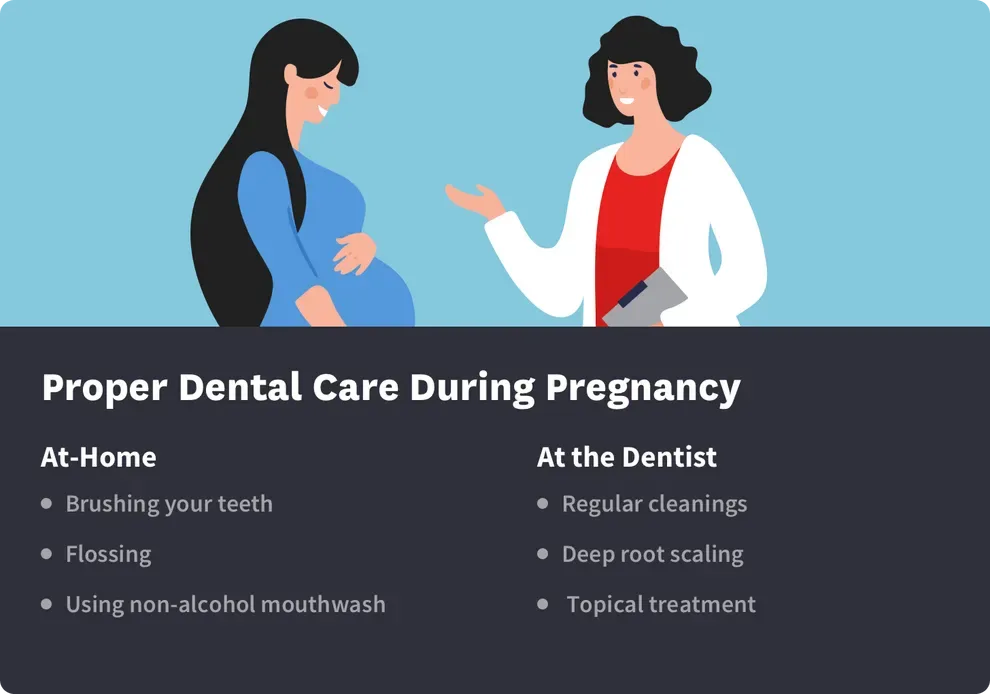
Mom's diet matters.
Your baby's teeth start forming between the third and the sixth month of your pregnancy, says the American Dental Association. A balanced diet gives your baby the key nutrients required to develop properly.
Look at your plate at each meal and ensure that it includes:
Fruits and vegetables. These should fill at least half of your plate.
Grains. Choose whole grains, and let this food fill a fourth of your plate.
Protein. Pick lean cuts of beef and chicken, and eat pregnancy-safe seafood too. A small serving should round out the meal.
Moms need plenty of water during pregnancy, but milk products can be an exceptional choice as well. Researchers say that moms who take in high levels of dairy products have babies with a lower risk of dental disease. This effect is most pronounced in mothers who eat cheese, so that can be a good between-meal snack.
After a heavy meal, nausea might set in. If it does, the food you ate can come right back up. Acid from your vomit can be incredibly hard on your teeth. While it's reasonable to reach for a toothbrush to wash it away, that's not wise.
Researchers say brushing after vomiting means scraping enamel away. Instead, use a rinse of a teaspoon of baking soda dissolved in a cup of water.
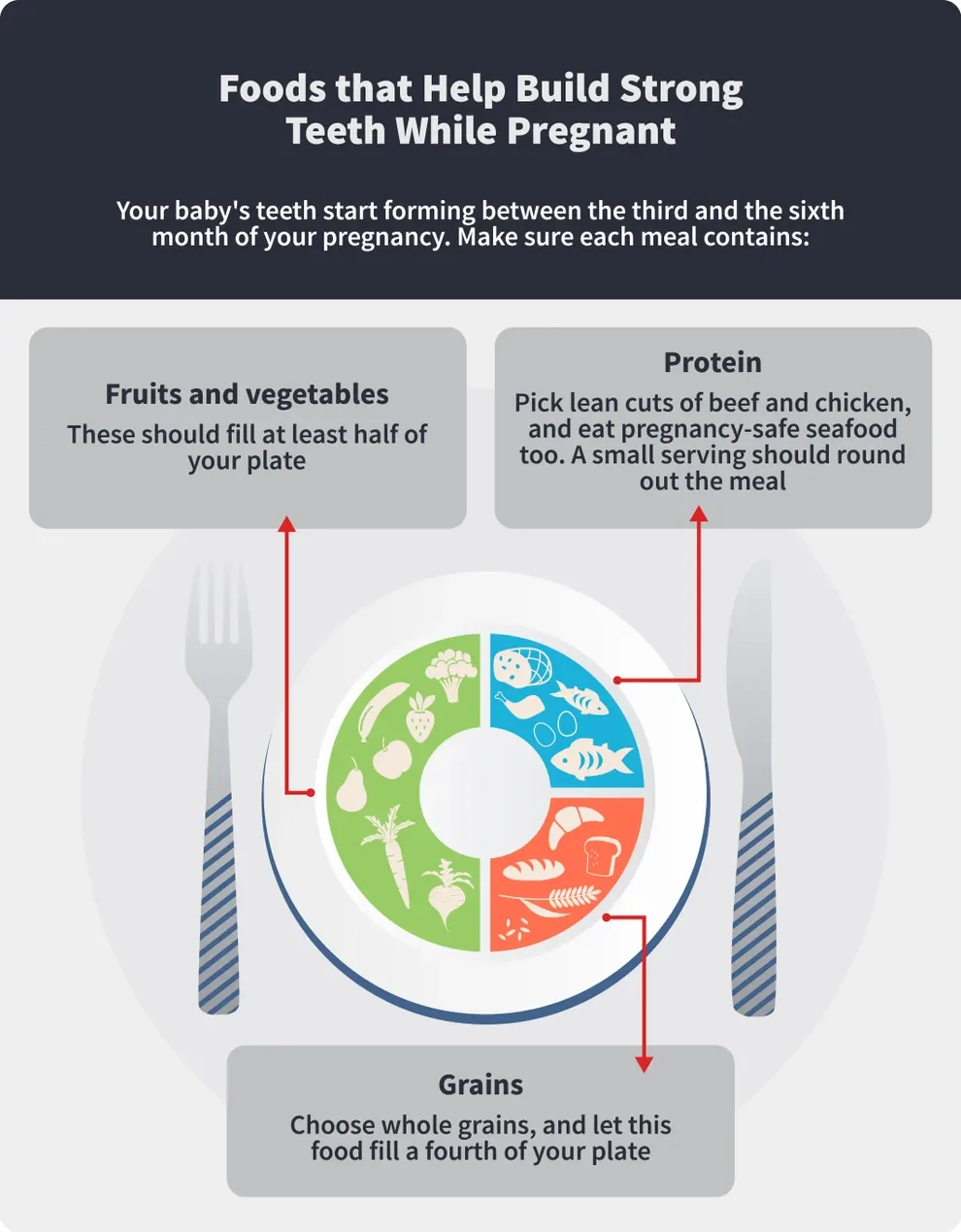
Early childhood and dental health.
About 28 percent of kids ages 2 to 5 years have some degree of tooth decay, says the National Institutes of Health.
Dentists can treat these issues effectively, of course. But most parents would prefer to avoid these problems rather than treating them after they happen. A few routine steps can help.
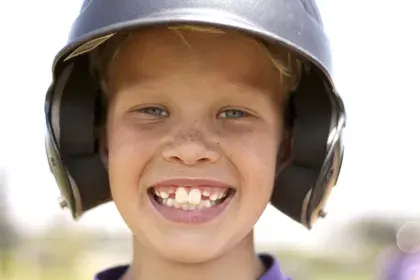
At-home care.
Don't wait to start your baby on a lifelong, healthy-mouth habit. The Centers for Disease Control and Prevention says parents can wipe down a baby's gums twice per day with a soft, clean cloth until the teeth begin to push through the gums. Then, it's time to use a soft-bristle toothbrush to clean your baby's teeth.
From the moment the first tooth breaks through until the end of a person's life, oral care is critical. During early childhood, parents set a foundation for a lifetime of good habits. Make that easier with a few quick tips:
Don't tell your child to brush and floss when you won't take the same steps. Take care of your teeth, and ensure that your child sees your commitment.
You could even use your child as a mirror for your next dental session, experts say, and ask for an accurate representation of your every move.
Create a chart, and give your child a sticker for each time the brushing is done, experts recommend. Your child will see all of that hard work accumulating.
Each toothbrushing lesson should last for 2 minutes. Look for songs about toothbrushing (we have a few ideas), and sing them as you brush. Or just cue up your child's favorite song and play that loud and clear while you clean.
You know your child better than anyone else does, and you know what will and won't make sense as a motivational tool. Don't be afraid to get creative as you entice your child to clean up that smile.
Nothing makes a parent's heart swell like a child's bright smile. The decisions parents make, including those made during pregnancy, can influence how bright that smile really is.
Work with a professional.
You'll do a lot to set good habits for your child. But you'll also need an expert's help.
Your child should visit the dentist as soon as the first tooth appears, says the American Dental Association. If your child's teeth haven't come in by their first birthday, make an appointment then.
Before the day of the appointment, prepare your child. Explain what the visit is for, and outline what the doctor will do. A few sessions of pretend and playacting could help your child feel more comfortable with what's to come.
A child's reaction to the dentist tends to vary by age, experts say. Children younger than 2 years old will need to stay with their parents throughout the visit to feel secure. Older children may say "no" or assert their rights when they feel threatened.
Don't be surprised if the way your child acts at home is different than the behaviors you see while visiting the dentist. This is all new for kids, and the experience can be overwhelming.
Some children develop a fear of the dentist, experts say. It's often a transfer problem, as parents with fears about oral care pass that on to their kids through their body language and instructions.
If you have dental anxiety, use meditation or exercise to calm your mind before the visit starts. And work with a pediatric dentist who knows how to soothe a worried child. Some kid-focused dentists use humor, tricks, and games to make even the most worried children feel more comfortable.
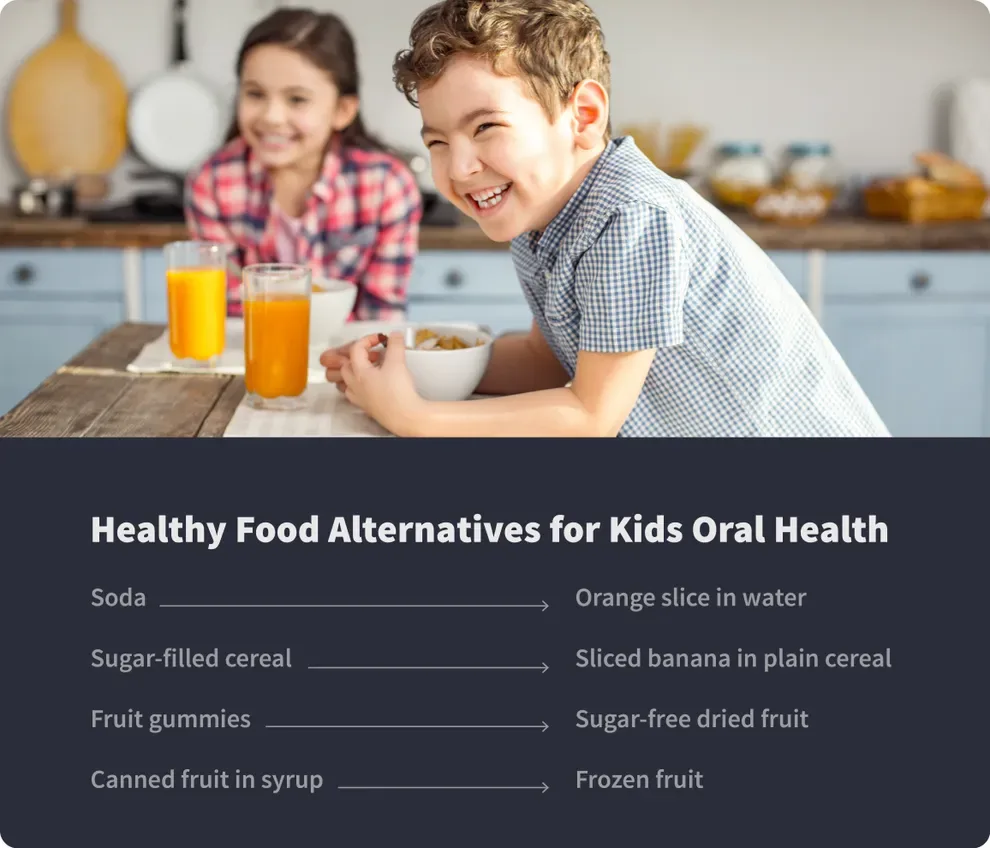
Choosing healthy foods.
If given the choice, most kids would load up their plates with sweet treats. Childhood taste buds are attuned to sweetness, and letting cravings run wild can lead to tooth decay and discomfort.
Experts say kids 1 and older should get less than 10 percent of their daily calories from sugar. That means most little ones shouldn't eat things like cake, cookies, and pie regularly. These sweet treats should be reserved for special occasions only.
Rather than opting for sugary foods, try some recommended replacements. Instead of:
Soda, add an orange slice to plain water.
Sugar-filled cereal, try sliced banana in plain cereals.
Fruit gummies, opt for sugar-free dried apple.
Canned fruit in syrup, reach for frozen fruit.
Don't think of this as depriving your child of yummy treats. Instead, congratulate yourself for helping your child to develop healthy eating habits to protect oral health.
Dental health for the teen years.
During adolescence, kids take the lessons given by parents and give them a spin of individuality. It's impossible to control every decision your child makes during this time. (That wouldn't be ideal either. You want your child to grow and change.) But you still have a major influence on your child’s health.

Consider orthodontics.
Kids with noticeable tooth or jaw problems should visit an orthodontist by age 7, experts say. That early visit gives experts the opportunity to use tools like headgear and palate expanders to change jaw shape and tooth movement so later work isn't required.
But if your child needs more help, or no one noticed the crooked smile until later in life, adolescence is an ideal time to intervene.
During adolescence, your child's teeth are still growing and changing, and jawbones have open growth plates. Using tools now means straightening adult teeth into permanent positions for a healthy smile. Your doctor may choose:
These traditional tools are glued to teeth and connect via wires and rubber bands. They're visible, and sometimes, they're uncomfortable. But for kids in need of major renovations, they can be appropriate.
Prices of aligners and braces vary by doctor and region, experts say. Prepare to see a bill that hovers around $6,000 for traditional braces, and expect to pay less than half that if you choose at-home, doctor-supervised aligner products. Your insurance may cover some of the cost.
Support your child during this process by:
Understanding the program. Know when your child is due for an appointment or aligner swap.
Ensuring compliance. Go over the plan with your child, and make sure each step is followed as instructed.
Intervening when needed. If your child experiences intense pain or something seems amiss or askew, reach out to your child's team for help.
Straightening teeth takes time, and it's not unusual for kids to spend several months in teeth aligners or several years in braces. The more you can enforce compliance with the treatment plan, the shorter the treatment timeline will be.
Reinforce good habits.
You taught your child how to brush and floss early in life. As adolescence prompts independence, you may lose touch with what your child is or isn't doing to care for their teeth.
Experts say that adolescence often comes with a heightened cavity risk. Make sure your child takes these steps each day:
Use a soft-bristle brush, and keep up the activity for 2 minutes. Repeat every morning and night.
Regular dental visits, on a schedule set by the dentist, should continue throughout adolescence. It's a good time to talk with the dentist about:
Toothpaste supplies some of this critical element, experts say. But some children and teens benefit from a dentist-applied fluoride treatment.
Dentists use special polymers to bond to teeth and eliminate deep cracks where bacteria grow. These tools cut cavity risks.
Metal in the mouth can chip teeth and crack crowns. Some piercings can also cause allergic reactions, experts say. Teens should talk about piercings before they're put in, so dentists can explain all the risks.
Children joining contact sports should chat with dentists about their teeth. Mouthguards can be critical when a child takes a blow to the face during a game.
Some parents ask to sit in on dental visits to ask questions and hear the conversation. But as your child grows, your presence may seem unwelcome. Let your child decide your involvement level, and respect that decision.
Researchers say fear of the dentist tends to fade by age 14. The less you hover and suggest your child has something to worry about, the more you can help those feelings to disappear.
Parents play an important role.
Your child's health and well-being are critical. As a parent, you'll set the foundation for your child's teeth for the rest of life.
It's hard work, but each time you see pearly whites peeking out when your child smiles, you'll know your efforts were worthwhile.
